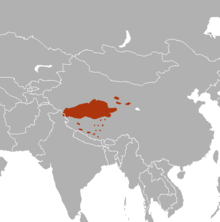Wild yak
| Wild yak | |
|---|---|

| |
| Scientific classification | |
| Domain: | Eukaryota |
| Kingdom: | Animalia |
| Phylum: | Chordata |
| Class: | Mammalia |
| Order: | Artiodactyla |
| Family: | Bovidae |
| Subfamily: | Bovinae |
| Genus: | Bos |
| Species: | B. mutus
|
| Binomial name | |
| Bos mutus Przewalski, 1883
| |

| |
| Distribution of Wild yak | |
The wild yak (Bos mutus) is a large wild bovid native to the Himalayas in Central Asia. It is the ancestor of the domestic yak (Bos grunniens).
Most yaks are domestic, which means they live on farms run by people. There are a few wild yak but there are not many left and are in danger of extinction.[2] There may be as few as 100 yak left in the wild.[2] Wild male yaks stand about 2–2.2 meters tall at the shoulder, the females about 1 metre. Domestic Yaks are shorter, between 1 and 2 metres for both males and females.[2] All yaks have long, thick hair to keep them warm in the cold places they live. Wild yaks can be black or brown. Some domestic yaks are white.[3] All kinds of yaks have horns.
Life[change | change source]
Yaks are herd animals. This means they live in groups called herds. Yaks are herbivores, they don't eat meat. The oldest yaks can live up to 25 years.[2]
References[change | change source]
- ↑ "Bos mutus". IUCN Red List of Threatened Species. 2016. IUCN: e.T2892A101293528. 2016. Retrieved 3 December 2016.
{{cite journal}}: Cite uses deprecated parameter|authors=(help) - ↑ 2.0 2.1 2.2 2.3 "UNEP - the Yak". Archived from the original on 2008-09-23. Retrieved 2008-09-05.
- ↑ "A picture of a white domestic yak".

